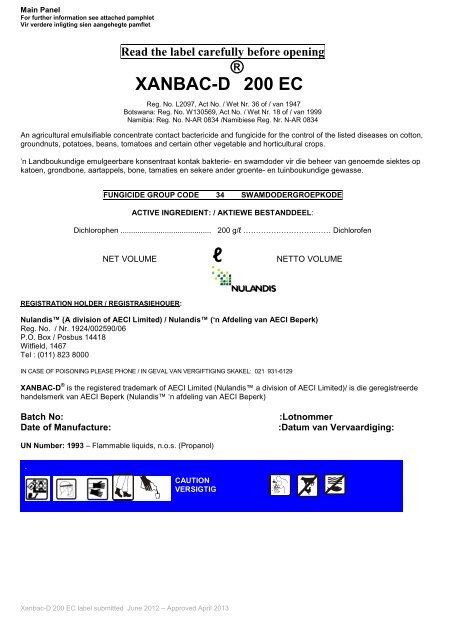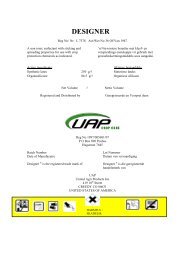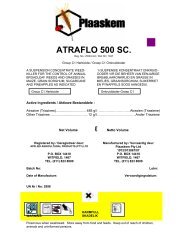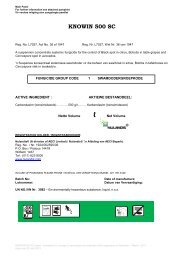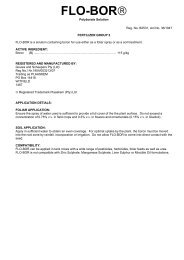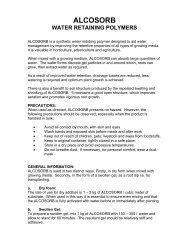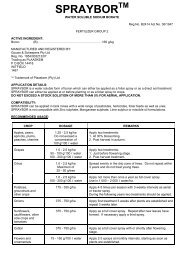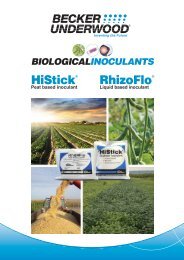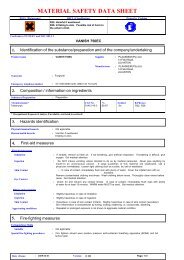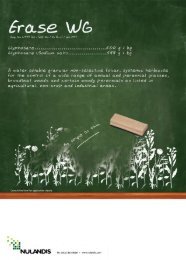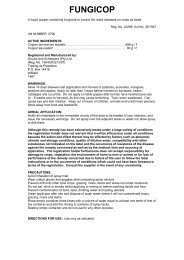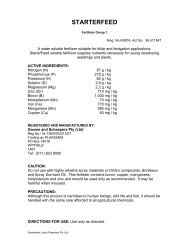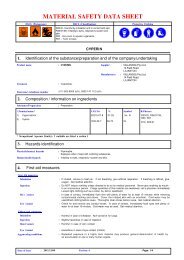Create successful ePaper yourself
Turn your PDF publications into a flip-book with our unique Google optimized e-Paper software.
Main Panel<br />
For further information see attached pamphlet<br />
Vir verdere inligting sien aangehegte pamflet<br />
Read the label carefully before opening<br />
XANBAC-D ® 200 EC<br />
Reg. No. L2097, Act No. / Wet Nr. 36 of / van 1947<br />
Botswana: Reg. No. W130569, Act No. / Wet Nr. 18 of / van 1999<br />
Namibia: Reg. No. N-AR 0834 /Namibiese Reg. Nr. N-AR 0834<br />
An agricultural emulsifiable concentrate contact bactericide and fungicide for the control of the listed diseases on cotton,<br />
groundnuts, potatoes, beans, tomatoes and certain other vegetable and horticultural crops.<br />
’n Landboukundige emulgeerbare konsentraat kontak bakterie- en swamdoder vir die beheer van genoemde siektes op<br />
katoen, grondbone, aartappels, bone, tamaties en sekere ander groente- en tuinboukundige gewasse.<br />
FUNGICIDE GROUP CODE 34 SWAMDODERGROEPKODE<br />
ACTIVE INGREDIENT: / AKTIEWE BESTANDDEEL:<br />
Dichlorophen ........................................... 200 g/ℓ ………………………..…… Dichlorofen<br />
NET VOLUME ℓ<br />
REGISTRATION HOLDER / REGISTRASIEHOUER:<br />
Xanbac-D 200 EC label submitted June 2012 – Approved April 2013<br />
NETTO VOLUME<br />
<strong>Nulandis</strong> (A division of AECI Limited) / <strong>Nulandis</strong> (‘n Afdeling van AECI Beperk)<br />
Reg. No. / Nr. 1924/002590/06<br />
P.O. Box / Posbus 14418<br />
Witfield, 1467<br />
Tel : (011) 823 8000<br />
IN CASE OF POISONING PLEASE PHONE / IN GEVAL VAN VERGIFTIGING SKAKEL: 021 931-6129<br />
XANBAC-D ® is the registered trademark of AECI Limited (<strong>Nulandis</strong> a division of AECI Limited)/ is die geregistreerde<br />
handelsmerk van AECI Beperk (<strong>Nulandis</strong> ‘n afdeling van AECI Beperk)<br />
Batch No: :Lotnommer<br />
Date of Manufacture: :Datum van Vervaardiging:<br />
UN Number: 1993 – Flammable liquids, n.o.s. (Propanol)<br />
.<br />
CAUTION<br />
VERSIGTIG
Pamphlet<br />
XANBAC-D ® 200 EC<br />
Reg. No. L2097, Act No. 36 of 1947<br />
Botswana: Reg. No. W130569, Act No. 18 of 1999<br />
Namibian Reg. No. N-AR 0834<br />
An agricultural emulsifiable concentrate contact bactericide and fungicide for the control of the listed diseases on cotton,<br />
groundnuts, potatoes, beans, tomatoes and certain other vegetable and horticultural crops.<br />
ACTIVE INGREDIENT:<br />
Dichlorophen.................................................………………………………………………………...... 200 g/ℓ<br />
REGISTRATION HOLDER :<br />
<strong>Nulandis</strong> (A division of AECI Limited)<br />
Reg. No. 1924/002590/06<br />
P.O. Box 14418<br />
Witfield, 1467<br />
Tel : (011) 823 8000<br />
XANBAC-D ® is the registered trademark of AECI Limited (<strong>Nulandis</strong> a division of AECI Limited)<br />
WARNINGS:<br />
FUNGICIDE GROUP CODE 34<br />
CAUTION<br />
ALLOW THE FOLLOWING MINIMUM NUMBER OF DAYS BETWEEN LAST APPLICATION AND HARVESTING;<br />
BEANS, TOMATOES, VEGETABLES & 3 DAYS<br />
OTHER EDIBLE CROPS<br />
COTTON DO NOT APPLY LATER THAN 14 DAYS BEFORE HARVESTING AND NOT AFTER BOLLS HAVE<br />
OPENED<br />
GROUNDNUT HAY DO NOT USE AS FODDER PRIOR TO 6 WEEKS AFTER LAST APPLICATION<br />
CUCUMBERS: PHYTOTOXICITY MAY OCCUR AT HIGH TEMPERATURES AND WHEN DOSAGE RATES HAVE<br />
BEEN EXCEEDED.<br />
Poisonous when swallowed.<br />
May cause skin irritation.<br />
Apply to edible crops as soon as it has been planted.<br />
Harmful to fish and other animals<br />
Store away from food and feedstuffs.<br />
Keep out of reach of children, uninformed persons and animals.<br />
FLAMMABLE: Do not store or handle near open flame.<br />
Re-entry : Do not enter treated area until spray deposit has dried unless wearing protective clothing.<br />
In case of poisoning – CALL A DOCTOR AND MAKE THIS LABEL AVAILABLE TO HIM.<br />
Aerial application - notify all inhabitants of the immediate area to be sprayed and issue the necessary warnings. Do not<br />
spray over or allow drift to contaminate water or adjacent areas.<br />
Xanbac-D 200 EC label submitted June 2012 – Approved April 2013
ALTHOUGH THIS REMEDY HAS BEEN EXTENSIVELY TESTED UNDER A LARGE VARIETY OF CONDITIONS THE<br />
REGISTRATION HOLDER DOES NOT WARRANT THAT IT WILL BE EFFICACIOUS UNDER ALL CONDITIONS BECAUSE THE<br />
ACTION AND EFFECT THEREOF MAY BE AFFECTED BY FACTORS SUCH AS ABNORMAL SOIL, CLIMATIC AND STORAGE<br />
CONDITIONS; QUALITY OF DILUTION WATER, COMPATIBILITY WITH OTHER SUBSTANCES NOT INDICATED ON THE<br />
LABEL AND THE OCCURRENCE OF RESISTANCE OF THE DISEASES AGAINST THE REMEDY CONCERNED AS WELL AS<br />
BY THE METHOD, TIME AND ACCURACY OF APPLICATION. THE REGISTRATION HOLDER FURTHERMORE DOES NOT<br />
ACCEPT RESPONSIBILITY FOR DAMAGE TO CROPS, VEGETATION, THE ENVIRONMENT OR HARM TO MAN OR ANIMAL<br />
OR FOR LACK OF PERFORMANCE OF THE REMEDY CONCERNED DUE TO FAILURE OF THE USER TO FOLLOW THE<br />
LABEL INSTRUCTIONS OR TO THE OCCURRENCE OF CONDITIONS WHICH COULD NOT HAVE BEEN FORESEEN IN<br />
TERMS OF THE REGISTRATION. CONSULT THE SUPPLIER IN THE EVENT OF ANY UNCERTAINTY.<br />
PRECAUTIONS:<br />
Do not inhale fumes or spray mist.<br />
Wear rubber gloves, boots and face shield when handling concentrate.<br />
Wash contaminated clothing immediately after spraying.<br />
Wash with soap and water immediately after use or accidental skin contact.<br />
Do not eat, drink or smoke whilst mixing or applying or before washing hands and face and changing clothes.<br />
Prevent contamination of food, feed, drinking water and eating utensils.<br />
Prevent drift onto other edible crops, grazing, rivers, dams and areas not under treatment.<br />
Clean applicator thoroughly with Flushsol before re-using and dispose of wash water where it will not contaminate crops,<br />
grazing, rivers and dams. Refer to the Flushsol label for directions of use.<br />
When empty, invert the container over the spray tank or mixing tank and allow it to drain for at least 30 seconds after the<br />
flow has slowed down to a drip. Thereafter rinse the container three times with a volume of water equal to at least one<br />
tenth of that of the container and add the rinsings to the contents of the spray tank. Destroy the container by puncturing<br />
and burying or burning it. Do not use the container for any other purpose.<br />
RESISTANCE WARNING:<br />
For resistance management, Xanbac-D 200 EC is a group code 34 fungicide. Any fungus may contain individuals<br />
naturally resistant to Xanbac-D 200 EC and other group code 34 fungicides. The resistant individuals can eventually<br />
dominate the fungus if these fungicides are used repeatedly. The resistant fungi may not be controlled by<br />
Xanbac-D 200 EC or any other group code 34 fungicide.<br />
To delay fungicide resistance:<br />
• Avoid exclusive repeated use of fungicides from the same fungicide group codes. Alternate with fungicides of<br />
different fungicide group codes, or use tank mixtures of different fungicide group codes.<br />
• Integrate other control methods [chemical, cultural, biological] into disease control programmes.<br />
For specific information on resistance management contact the registration holder of this product.<br />
DIRECTIONS FOR USE: USE ONLY AS DIRECTED<br />
AERIAL APPLICATION:<br />
Aerial application may only be done by a registered aerial application operator using a correctly calibrated, registered<br />
aircraft according to the instructions of SANS Code 10118 (Aerial Application of Agricultural Remedies). It is important<br />
to ensure that the spray mixture is distributed evenly over the target area and that the loss of spray material during<br />
application is restricted to a minimum. It is therefore essential that the following criteria are met:<br />
Equipment:<br />
Use suitable atomizing equipment (hydraulic nozzles or rotary atomizers) that will produce the desired droplet size and<br />
coverage, but which will ensure the minimum loss of product through drift.<br />
The operator must use a setup that will produce a droplet spectrum with the lowest possible relative span.<br />
All nozzles / atomisers should be positioned within the inner 75 % of the wingspan to prevent droplets from entering the<br />
wingtip vortices.<br />
Xanbac-D 200 EC label submitted June 2012 – Approved April 2013
Application parameters:<br />
A minimum volume of 30 – 40 l spray mixture per hectare is recommended. As this product has not been evaluated at a<br />
reduced volume rate, the registration holder cannot guarantee efficacy, or be held responsible for any adverse effects if<br />
this product is applied aerially at a lower volume rate than recommended above.<br />
A droplet coverage of 50 - 70 droplets per cm 2 must be recovered at the target. The CV for droplet distribution must not<br />
exceed 40 %.<br />
A droplet spectrum with a VMD (Volume Median Diameter) of 250 is recommended. Ensure that the production of fine<br />
droplets (smaller than 150 microns) is restricted to a minimum.<br />
The height of the spray boom should be maintained at 3-4 metres above the target. Do not spray when aircraft is in a<br />
climb, at the top or during a dive, or when banking.<br />
Apply before the crop becomes too dense, thus preventing proper coverage of the plants.<br />
Meteorological conditions:<br />
The difference between the wet and dry bulb readings as determined by a whirling hygrometer, must not exceed 8 °C<br />
Do not spray under turbulent, unstable conditions during the heat of the day when rising thermals and downdraughts<br />
occur.<br />
Do not spray under temperature inversion conditions (spraying in or above the inversion layer).<br />
Do not spray if the wind speed exceeds 15 km/h.<br />
General:<br />
Ensure that fields are accurately marked and that the aerial spray operator knows exactly which fields to spray.<br />
Obtain an assurance from the aerial spray operator that the above requirements will be met.<br />
COMPATIBILITY:<br />
XANBAC-D 200 EC is an alkaline formulation. Do not apply with any other product which will reduce the pH in the<br />
spray tank or fertilizer concentrate tank feeding to pivot, drip or conventional irrigation systems (e.g. incompatible with<br />
ammonium nitrate). XANBAC-D 200 EC is only compatible with alkaline pesticides and foliar feeds. Do not mix<br />
XANBAC- D 200 EC with products which will lower the pH in the spray tank (spraying) and fertilizer concentration tank<br />
(fertigation). Use a suitable adjuvant to enhance the activity of XANBAC-D 200 EC. When using XANBAC-D 200 EC<br />
in combination with CungFu 538 SC (Reg. No. L7526, Act No. 36 of 1947) or Kocide 2000 (Reg. No. L6137, Act No. 36<br />
of 1947) use a sticker such as Bio-Film (Reg. No. L3684, Act No. 36 of 1947). When used alone as a foliar spray, add<br />
a suitable sticker such as Bio-Film (Reg. No. L3684, Act No. 36 of 1947). Do not add any acidifier or adjuvant with<br />
acidifying features.<br />
APPLICATION METHODS:<br />
Leaf application:<br />
For additional fungal and bacterial disease control it is advisable to combine CungFu 538 SC /Kocide 2000 with<br />
XANBAC-D 200 EC applications in sufficient water to ensure complete coverage of the plants.<br />
Soil application:<br />
For control of soil borne diseases XANBAC-D 200 EC may be applied via the irrigation system or as a drench. If<br />
applied by pivot, the irrigation cycle should be operated at maximum speed i.e. 5 - 7 mm. The degree of infection will<br />
determine the volume of water applied. It is of utmost importance to apply XANBAC-D 200 EC in sufficient water to<br />
penetrate and to reach the source of infection or permit adequate protection e.g. potato tubers. It is essential that<br />
infection be monitored at a constant basis. XANBAC-D 200 EC should not be applied to plants in tunnels, if the plants<br />
are under stress. Application to crops under protection should be aimed at the root zone in sufficient water (2 l / 1000 l<br />
water) applied when necessary. Do not use XANBAC-D 200 EC in closed hydroponic systems or in any instance where<br />
water is circulated.<br />
Xanbac-D 200 EC label submitted June 2012 – Approved April 2013
Basal Plant Treatments:<br />
Where stem infections appear either at or below soil level, special care must be taken to wet the target area thoroughly.<br />
In such cases use XANBAC-D 200 EC as a drench, in not less than 1 000 ℓ water/ha, or as transplant solutions.<br />
Sanitation:<br />
To prevent contamination of disease free lands with soil borne diseases, ensure that no movement of tractors,<br />
implements or labourers takes place from infected areas.<br />
APPLICATION TABLE:<br />
CROP<br />
FIELD CROPS:<br />
POTATOES<br />
COTTON<br />
DISEASE<br />
STEM CANKER<br />
(Rhizoctonia solani)<br />
ANGULAR LEAF<br />
SPOT<br />
(Bacterial blight)<br />
(Xanthomonas<br />
malvacearum)<br />
APPLICATION RATE<br />
PER 100 ℓ WATER<br />
OR AS INDICATED<br />
1 ℓ/ha<br />
1.5 ℓ/ha<br />
1 – 1.5 ℓ/ha<br />
3 ℓ/ha<br />
3 ℓ/ha<br />
3 ℓ/ha<br />
Xanbac-D 200 EC label submitted June 2012 – Approved April 2013<br />
REMARKS<br />
1st Treatment: At planting: Apply as a row<br />
application over the seed potatoes in a minimum<br />
of 500 ℓ water/ha. Close furrow immediately after<br />
application.*<br />
2nd Treatment: At or prior to emergence. Apply<br />
via sprinkler or pivot irrigation with 5-10 mm<br />
(ie. 50 000 – 100 000 ℓ) water/ha, depending on<br />
soil type. Use the lower water volume on sandy<br />
soils and the higher volume on heavy soils.<br />
3rd Treatment: Summer plantings: An additional<br />
XANBAC-D 200 EC application should be made<br />
before the flowering stage.<br />
If the above preventative programme has not<br />
been followed, XANBAC-D 200 EC may be<br />
applied at 3 ℓ/ha as a corrective treatment as<br />
soon as the first symptoms are noticed.<br />
Repeat 7 days later where a high infection<br />
pressure persists.<br />
* With furrow application, the best results will be<br />
obtained by mounting one fan jet nozzle over the<br />
opened plant furrow and one solid cone nozzle in<br />
a position to spray the covering soil.<br />
Ground application: Apply 125-200 ℓ water/ha.<br />
APPLY AT:<br />
1) Early square stage.<br />
2) Square stage (first flowers) 45-60 days<br />
after planting<br />
3) First bolls (60 - 80 days after planting)<br />
4) 7-14 days after 3rd spray<br />
5) 7-14 days after 4th spray<br />
Aerial application: Apply in 30-40 ℓ water/ha.
CROP<br />
VEGETABLES:<br />
COLE CROPS<br />
LETTUCE<br />
CUCUMBERS<br />
GREEN PEPPERS<br />
SEEDLINGS<br />
GENERALLY:<br />
VEGETABLES,<br />
FLOWERS,<br />
ORNAMENTALS,<br />
ETC.<br />
HYDROPONIC<br />
SOLUTIONS<br />
TOMATOES<br />
DISEASE<br />
BACTERIAL SPOT<br />
(Pseudomonas<br />
maculicola)<br />
ROT<br />
(Pythium spp;<br />
Rhizoctonia solani;<br />
Botrytis cinerea)<br />
CUCUMBER WILT<br />
(Pythium spp.)<br />
DAMPING-OFF<br />
DAMPING-OFF<br />
ALGAE spp.<br />
DAMPING-OFF<br />
(Rhizoctonia solani<br />
and Pythium spp.)<br />
APPLICATION RATE<br />
PER 100 ℓ WATER<br />
OR AS INDICATED<br />
200 mℓ<br />
3 ℓ/ha<br />
2 ℓ/ha<br />
300 mℓ<br />
200 mℓ<br />
200 mℓ<br />
200 mℓ<br />
100 mℓ<br />
200 mℓ<br />
100 mℓ<br />
10 mℓ/100 ℓ<br />
200 mℓ<br />
1.0 - 1.5 ℓ/ha<br />
Xanbac-D 200 EC label submitted June 2012 – Approved April 2013<br />
REMARKS<br />
Commence spraying at the first signs of disease.<br />
Repeat at 7-14 day intervals if necessary, using<br />
not less than 500 ℓ spray mixture per hectare.<br />
Pre-plant: Apply in at least 500 ℓ water/ha as a<br />
total surface spray.<br />
Post-planting: Apply as a cover spray when the<br />
first signs of the disease appear and repeat every<br />
7-14 days if necessary.<br />
Pre-seeding: Apply as a drench using 400 mℓ of<br />
XANBAC-D 200 EC mixture per 10 ℓ plastic<br />
container.<br />
Post emergence: In case of re-infection repeat<br />
drench treatment as indicated above, using the<br />
200 mℓ / 100 ℓ water concentration.<br />
Note: Phytotoxicity may occur if the specified<br />
dosage rate is increased and at temperatures<br />
above 35°C.<br />
Apply as a drench treatment over established<br />
plants in seedling trays.<br />
Growth medium treatment:<br />
Pre-seeding: Use 40 ℓ of the XANBAC-D 200 EC<br />
mixture to treat one cubic metre of growth medium.<br />
Seedlings: Above application should be followed<br />
up with a drench treatment once the seedlings are<br />
established.<br />
Seedbed treatment:<br />
Pre-emergence: Apply as a drench treatment.<br />
Post-emergence: Apply as a drench treatment<br />
and repeat every 7-10 days depending on disease<br />
pressure.<br />
Treat water source every 4-5 weeks depending on<br />
degree of algal growth.<br />
Apply as a post-plant drench at ± 50-100 mℓ<br />
mixture per plant depending on size of plant.<br />
For drip irrigated tomatoes apply via<br />
drip at 1 - 1.5 ℓ/ha depending on size<br />
of plant.
BEANS<br />
CROP<br />
ONIONS &<br />
GARLIC<br />
GROUNDNUTS<br />
DISEASE<br />
ROOT ROT<br />
(Rhizoctonia solani and Pythium<br />
spp.)<br />
WHITE BULB ROT<br />
(Sclerotium cepivorum)<br />
PINK ROOT<br />
(Pyrenochaeta terrestris)<br />
LEAF SPOT (Cercospora<br />
arachidicola)<br />
WEB BLOTCH<br />
(Phoma arachidicola)<br />
Xanbac-D 200 EC label submitted June 2012 – Approved April 2013<br />
APPLICATION RATE<br />
PER 100 ℓ WATER OR<br />
AS INDICATED<br />
20 mℓ/100 m row<br />
2 ℓ/ha<br />
2-3 ℓ/ha<br />
2-3 ℓ/ha<br />
2-3 ℓ/ha<br />
REMARKS<br />
Bio-Film ® is the registered trademark of AECI Limited (<strong>Nulandis</strong> a division of AECI Ltd.)<br />
Pre-emergence or at emergence: Apply<br />
as a row treatment with planting or at<br />
emergence. Use 20 mℓ XANBAC-D 200<br />
EC in at least 3 ℓ water per 100 m plant<br />
row.<br />
Post emergence: Use in at least 500 ℓ<br />
water/ha to ensure good spray cover.<br />
Inspect seedbeds regularly and spray<br />
immediately when disease is<br />
observed, or apply the following<br />
programme:<br />
Seedlings: Commence treatment at<br />
4-6 true leaf stage and repeat every<br />
14 days or at shorter intervals if<br />
necessary.<br />
Transplants: Apply the first application<br />
when 2-4 new leaves have formed<br />
after transplanting. Repeat within<br />
14 days or when necessary.<br />
Sets: Commence treatment with<br />
emergence of the 6-8th leaf and<br />
repeat after 14 days or when<br />
necessary. Apply by means of<br />
irrigation system in at least 3-5 mm<br />
(30 000 - 50 000 ℓ) water/ha or<br />
spray in a minimum volume of 800 ℓ<br />
water per hectare and irrigate<br />
immediately after application with 3-<br />
5 mm water. A rigid programme<br />
should be followed, but if yellow,<br />
disease patches appear in the field<br />
these should be treated individually<br />
at the higher rate (see notes on<br />
sanitation).<br />
Apply the first treatment 3 weeks after<br />
emergence. Use the higher dosage<br />
where groundnuts were planted<br />
repeatedly.<br />
Depending on rainfall, prevailing<br />
temperatures and disease pressure<br />
follow up with 3-4 applications at 2-3<br />
weekly intervals and use the lower rate.<br />
Do not apply in less than 400 ℓ water<br />
per hectare.<br />
For the suppression of web blotch, apply<br />
as above.<br />
CungFu 538 SC & Kocide 2000 are the registered tradenames of <strong>Nulandis</strong> (A division of AECI Ltd.)
Pamflet<br />
XANBAC-D ® 200 EC<br />
Reg. Nr. L2097, Wet Nr. 36 van 1947<br />
Namibiese Reg. Nr. N-AR 0834<br />
’n Landboukundige emulgeerbare konsentraat kontak bakterie- en swamdoder vir die beheer van genoemde siektes op<br />
katoen, grondbone, aartappels, bone, tamaties en sekere ander groente en tuinboukundige gewasse.<br />
AKTIEWE BESTANDDEEL:<br />
Dichlorofen......................................………….........…………………………………………............ 200 g/ℓ<br />
REGISTRASIEHOUER:<br />
<strong>Nulandis</strong> (‘n Afdeling van AECI Beperk)<br />
Reg. Nr. 1924/002590/06<br />
Posbus 14418<br />
Witfield, 1467<br />
Tel : (011) 823 8000<br />
XANBAC-D ® is die geregistreerde handelsmerk van AECI Beperk (<strong>Nulandis</strong> ‘n afdeling van AECI Beperk)<br />
WAARSKUWINGS:<br />
SWAMDODERGROEPKODE 34<br />
VERSIGTIG<br />
LAAT DIE VOLGENDE MINIMUM AANTAL DAE TOE TUSSEN LAASTE TOEDIENING EN OES:<br />
BONE, TAMATIES, GROENTE &<br />
ANDER EETBARE GEWASSE 3 DAE<br />
KATOEN: MOENIE LATER AS 14 DAE VOOR OES EN NADAT BOLLE BEGIN OOPMAAK TOEDIEN NIE<br />
GRONDBOON HOOI: MOENIE VOOR 6 WEKE NA LAASTE BESPUITING VIR VOER DOELEINDES GEBRUIK NIE<br />
KOMKOMMERS: FITOTOKSISITEIT MAG VOORKOM TEEN HOë TEMPERATURE EN WANNEER<br />
TOEDIENINGSHOEVEELHEDE OORSKRY WORD<br />
Giftig wanneer ingesluk.<br />
Mag velirritasie veroorsaak.<br />
Eetbare gewasse behoort behandel te word sodra die plante uitgeplant word.<br />
Skadelik vir visse en ander diere.<br />
Berg weg van voedsel en voer.<br />
Hou buite bereik van kinders, oningeligte persone en diere.<br />
VLAMBAAR: Moenie naby oop vuur geberg of hanteer word nie.<br />
Herbetreding: Moenie behandelde gebied binnegaan alvorens die spuitneerslag droog is nie, tensy beskermende oorklere<br />
gedra word.<br />
In geval van vergiftiging - ONTBIED 'N GENEESHEER EN STEL HIERDIE ETIKET AAN HOM BESKIKBAAR.<br />
Lugtoediening - stel alle persone in die onmiddellike omgewing van die gebied wat behandel gaan word in kennis en reik<br />
die nodige waarskuwings uit. Moenie aangrensende gebiede of waterbronne bespuit of toelaat dat die sproeinewel<br />
daarheen oorwaai nie.<br />
Xanbac-D 200 EC label submitted June 2012 – Approved April 2013
ALHOEWEL HIERDIE MIDDEL OMVATTEND ONDER 'N GROOT VERSKEIDENHEID TOESTANDE GETOETS IS<br />
WAARBORG DIE REGISTRASIEHOUER NIE DAT DIT ONDER ALLE TOESTANDE DOELTREFFEND SAL WEES NIE<br />
AANGESIEN DIE WERKING EN EFFEK DAARVAN BEïNVLOED KAN WORD DEUR FAKTORE SOOS ABNORMALE<br />
GROND-, KLIMAATS- EN BERGINGSTOESTANDE, KWALITEIT VAN VERDUNNINGSWATER, VERENIGBAARHEID<br />
MET ANDER STOWWE WAT NIE OP DIE ETIKET AANGEDUI IS NIE EN DIE VOORKOMS VAN WEERSTAND VAN<br />
DIE SIEKTES TEEN DIE BETROKKE MIDDEL SOWEL AS DIE METODE, TYD EN AKKURAATHEID VAN<br />
TOEDIENING. VERDER AANVAAR DIE REGISTRASIEHOUER NIE VERANTWOORDELIKHEID VIR SKADE AAN<br />
GEWASSE, PLANTEGROEI, DIE OMGEWING OF VIR NADELIGE EFFEK OP MENS OF DIER OF VIR 'N GEBREK<br />
AAN PRESTASIE VAN DIE BETROKKE MIDDEL AS GEVOLG VAN DIE VERSUIM VAN DIE GEBRUIKER OM<br />
ETIKETAANWYSINGS NA TE KOM OF AS GEVOLG VAN DIE ONTSTAAN VAN TOESTANDE WAT NIE KRAGTENS<br />
DIE REGISTRASIE VOORSIEN KON WORD NIE. RAADPLEEG DIE VERSKAFFER IN DIE GEVAL VAN ENIGE<br />
ONSEKERHEID.<br />
VOORSORGMAATREëLS:<br />
Vermy inaseming van dampe of sproeinewel.<br />
Dra rubberhandskoene-, skoene en gesigskerm wanneer konsentraat hanteer word.<br />
Was besoedelde klere onmiddellik na bespuiting. Was onmiddellik na toediening of toevallige velkontak met seep en<br />
water.<br />
Moenie eet, drink of rook tydens vermenging of toediening, of voodat hande en gesig gewas en skoon klere aangetrek is<br />
nie.<br />
Verhoed besoedeling van voedsel, voer, drinkwater en eetgerei.<br />
Verhoed wegdrywing van die sproeinewel na ander gewasse, weidings, riviere, damme of ander gebiede wat nie behandel<br />
word nie.<br />
Maak toedieningsapparaat skoon met FLUSHSOL voor her-gebruik en doen weg met waswater waar dit nie gewasse,<br />
weiding, riviere en damme sal besoedel nie. Verwys na die FLUSHSOL etiket vir gebruiksaanwysings.<br />
Sodra die houer leeg is keer dit om oor die spuittenk of mengbak en dreineer vir minstens 30 sekondes nadat die vloei tot<br />
'n gedrup verminder het. Spoel die houer daarna driekeer uit met ‘n volume water gelyk aan minstens ‘n tiende van die<br />
houer en gooi die spoelwater by die inhoud van die spuittenk. Vernietig die houer deur gate daarin te maak en te begrawe<br />
of te verbrand. Moenie die houer vir enige ander doel gebruik nie.<br />
WEERSTANDSWAARSKUWING:<br />
XANBAC-D 200 EC is ‘n groepkode 34 swamdoder. Enige populasie van ‘n spesifieke swam mag individue insluit wat ‘n natuurlike<br />
weerstand teen XANBAC-D 200 EC of enige ander groepkode 34 swamdoder het. Indien hierdie swamdoders herhaaldelik<br />
aangewend word, kan die weerstandbiedende individue uiteindelik die swampopulasie oorheers. Hierdie weerstandbiedende<br />
swamme sal waarskynlik nie deur XANBAC-D 200 EC of enige ander groepkode 34 swamdoder beheer word nie.<br />
Om weerstand teen swamdoders te vertraag:<br />
• Vermy die eksklusiewe herhaaldelike gebruik van swamdoders in dieselfde swamdodergroepkode. Wissel af met<br />
swamdoders van verskillende swamdoder groepkodes of gebruik tenkmengsels van verskillende swamdoder<br />
groepkodes.<br />
• Integreer ander beheermaatreëls (chemise, verbouing, biologies) in siektebeheerprogramme.<br />
Vir spesifieke inligting oor weerstandsbestuur kontak die registrasiehouer van hierdie produk<br />
GEBRUIKSAANWYSINGS: GEBRUIK SLEGS SOOS AANGEDUI<br />
LUGTOEDIENING:<br />
Lugtoediening mag slegs deur ‘n geregistreerde lugbespuitingsoperateur met ‘n korrek gekalibreerde, geregistreerde<br />
vliegtuig volgens die instruksies van SANS 10118 (Aerial Application of Agricultural Remedies) gedoen word. Dit is<br />
belangrik om te verseker dat die spuitmengsel eweredig oor die teikenarea versprei word en dat die verlies aan<br />
spuitmengsel tydens toediening tot ‘n minimum beperk word. Dit is dus belangrik om aan die volgende kriteria te<br />
voldoen:<br />
Xanbac-D 200 EC label submitted June 2012 – Approved April 2013
Toerusting:<br />
q Gebruik geskikte atomiseringsapparaat (hidroliese of roterende spuitkoppe) wat die vereiste druppelgrootte en<br />
bedekking sal produseer, maar wat die minste verlies van produk deur wegdrywing sal verseker.<br />
q Die operateur moet ‘n stelsel gebruik wat ‘n druppelspektrum met die kleinste moontlike relatiewe span sal<br />
produseer.<br />
q Al die spuitneuse/atomiseerders moet in die binneste 75 % van die vlerkspan geplaas word om die beweging van<br />
druppels in die vlerkvorteks in te verhoed.<br />
Toedieningsparameters:<br />
q ‘n Minimum volume van 30 – 40 l spuitmengsel per hektaar word aanbeveel. Aangesien hierdie produk nie teen ‘n<br />
verlaagde volume getoets is nie, kan die registrasiehouer nie effektiwiteit waarborg, of verantwoordelik gehou word<br />
vir enige nadelige effek indien hierdie produk teen ‘n laer volume as hierbo aanbeveel, uit die lug toegedien word<br />
nie.<br />
q ‘n Druppelbedekking van 50 - 70 druppels per cm 2 moet op die teikenarea herwin word.<br />
q ‘n Druppelspektrum met ‘n VMD van 250 mikron word aanbeveel. Verseker dat die produksie van fyn druppels<br />
(kleiner as 150 mikron) tot ‘n minimum beperk word.<br />
q Die hoogte van die spuitbalk moet op 3-4 meter bo die teiken gehandhaaf word. Moenie spuit wanneer die vliegtuig<br />
aan die bopunt is van, of tydens ‘n duik, of terwyl dit uitklim of draai nie.<br />
q Dien toe voordat die gewas te ruig word wat sal verhoed dat plante behoorlik bedek word.<br />
q<br />
Meteorologiese toestande :<br />
q Die verskil tussen die nat- en droëbollesing, soos met ‘n swaaihigrometer bepaal, moet nie 8°C oorskry nie.<br />
q Moenie toedien tydens turbulente, onstabiele toestande gedurende die hitte van die dag wanneer styg en dalende<br />
konveksie windbeweging plaasvind nie.<br />
q Moenie toedien onder temperatuur inversie toestande (deur bo of binne die inversielaag te spuit) nie.<br />
q Moenie spuit indien die windspoed 15 km/uur oorskry nie.<br />
Algemeen :<br />
q Sorg dat die lande akkuraat gemerk is en die spuitoperateur presies weet watter lande gespuit moet word.<br />
q Verkry ‘n versekering van die spuitoperateur dat aan die bogenoemde vereistes voldoen sal word.<br />
VERENIGBAARHEID:<br />
XANBAC-D 200 EC is ‘n alkaliese produk en moenie met enige middel gemeng word wat die pH sal verlaag van die<br />
spuitmengsel in die tenk of misstof konsentraattenk, wat die spilpunt, drup- of konvensionele besproeiingsisteem voed,<br />
nie (bv. onverenigbaar met ammonium nitraat). XANBAC-D 200 EC is slegs met alkaliese plaagdoders en misstowwe<br />
verenigbaar. Moenie XANBAC-D 200 EC met produkte meng wat die pH in die spuittenk (bespuiting) en misstof<br />
konsentrasietenk (spuitbemesting) sal verlaag nie. Gebruik ‘n geskikte bevorderingsmiddel om die uitwerking van<br />
XANBAC-D 200 EC te verbeter. Indien XANBAC-D 200 EC in kombinasie met CungFu 538 SC (Reg. Nr. L7526, Wet<br />
Nr. 36 van 1947) of Kocide 2000 (Reg. Nr. L6137, Wet Nr. 36 van 1947) gebruik word, word ‘n kleefmiddel soos Bio-<br />
Film (Reg. Nr. L3684, Wet Nr. 36 van 1947) aanbeveel. Indien XANBAC-D 200 EC alleen gebruik word as ‘n<br />
blaarbespuiting, voeg ‘n geskikte kleefmiddel soos Bio-Film (Reg. Nr. L3684, Wet Nr. 36 van 1947) by.<br />
Moenie ‘n versuurder of ‘n hulpmiddel met versurende eienskappe byvoeg nie.<br />
TOEDIENINGSMETODES:<br />
Looftoediening:<br />
Vir bykomende beheer van swam- en bakteriese siektes is dit raadsaam om CungFu 538 SC of Kocide 2000 in<br />
kombinasie met XANBAC-D 200 EC te gebruik in voldoende water, om sodoende volle bedekking van die plant te<br />
verseker.<br />
Grondtoediening:<br />
Vir die beheer van siektes in die grond mag XANBAC-D 200 EC via sprinkelbesproeiing óf as ‘n deurdrenking toegedien<br />
word. Indien deur middel van 'n spilpunt toegedien, moet die besproeiingsiklus op maksimum spoed gehandhaaf word,<br />
dit is 5 - 7 mm. Die graad van infeksie sal die volume water wat gebruik word , bepaal. Dit is van uiterste belang om<br />
XANBAC-D 200 EC met genoegsame hoeveelhede water toe te dien, om deur te dring en die ondergrondse<br />
besmettingsbronne te bereik, óf om voldoende beskerming te bied aan bv. aartappelknolle. Dit is belangrik dat die<br />
infeksie op ‘n konstante basis gemoniteer moet word. Moenie XANBAC-D 200 EC op plante in tonnels of onder druk,<br />
toedien nie. Toediening op gewasse onder beskerming moet gerig wees op die wortelsone in genoegsame water (2 l /<br />
1 000 l water), indien nodig. Moenie XANBAC-D 200 EC in suiwer water stelsel gebruik nie, dit wil sê in hidroponiese<br />
stelsels waar dieselfde water gesirkuleer word.<br />
Xanbac-D 200 EC label submitted June 2012 – Approved April 2013
Basale plantbehandeling:<br />
Waar stambesmettings op grondvlak óf ondergronds voorkom, moet spesiale aandag aan deeglike benatting van die<br />
teikenarea gegee word. In sulke gevalle gebruik XANBAC-D 200 EC as ‘n deurdrenking in nie minder as ‘n 1 000 ℓ<br />
water/ha nie, óf as uitplant oplossings.<br />
Sanitasie:<br />
Om kontaminasie van onbesmette landerye met grondoorgedraagde siektes te voorkom, maak seker dat geen<br />
beweging van trekkers, gereedskap en werkers vanaf besmette na onbesmette lande plaasvind nie.<br />
TOEDIENINGSTABEL:<br />
GEWAS<br />
AKKERBOUGEWASSE:<br />
AARTAPPELS<br />
SIEKTE<br />
STAMKANKER<br />
(Rhizoctonia<br />
solani)<br />
Xanbac-D 200 EC label submitted June 2012 – Approved April 2013<br />
TOEDIENINGS-<br />
HOEVEELHEID PER<br />
100 ℓ WATER OF<br />
SOOS<br />
AANGEDUI<br />
3 ℓ/ha<br />
3 ℓ/ha<br />
3 ℓ/ha<br />
OPMERKINGS<br />
Eerste Toediening: Tydens plant:<br />
Dien toe as 'n rybehandeling, oor die<br />
moere in 'n minimum van 500 ℓ<br />
water/ha. Maak die voor direk na<br />
toediening toe.*<br />
Tweede Toediening: Tydens óf<br />
voor opkoms: Dien toe via sprinkel-<br />
óf spilpuntbesproeiing in 5-10 mm<br />
(dit is 50 000 -100 000 l)<br />
water/ha, afhangende van die<br />
grondtipe. Gebruik die laer volume<br />
besproeiingswater vir sanderige<br />
grond, en die hoër volume vir swaar<br />
gronde.<br />
Derde Toediening:<br />
Someraanplantings: 'n Bykomende<br />
XANBAC-D 200 EC toediening<br />
behoort net vóór blomtyd toegedien<br />
te word.<br />
Indien bogenoemde voorkomende<br />
program nie gevolg is nie, mag<br />
XANBAC-D 200 EC toegedien<br />
word teen 3 ℓ/ha as ‘n korrektiewe<br />
behandeling sodra die eerste<br />
tekens van besmetting<br />
waargeneem word. Herhaal 7 dae<br />
later waar ‘n hoë besmettingsdruk<br />
aanhou.<br />
* Vir die beste resultate by voorbehandeling,<br />
posisioneer een<br />
platwaaier-spuitkop oor die oop<br />
plantvoor en een soliede koniese<br />
spuitkop in 'n posisie om die grond<br />
te spuit wat die voor toemaak.
KATOEN<br />
GEWAS<br />
GROENTEGEWASSE:<br />
KOOLGEWASSE<br />
SLAAI<br />
KOMKOMMERS<br />
GROENRISSIES<br />
SIEKTE<br />
HOEKIGE BLAARVLEK<br />
(Bakteriese<br />
skroeisiekte)<br />
(Xanthomonas<br />
malvacearum)<br />
BAKTERIESE VLEK<br />
(Pseudomonas<br />
maculicola)<br />
VROT<br />
(Pythium spp.;<br />
Rhizoctonia solani;<br />
Botrytis cinerea)<br />
KOMKOMMER<br />
VERWELKSIEKTE<br />
(Pythium spp.)<br />
SAAILING-<br />
VERWELKSIEKTE<br />
Xanbac-D 200 EC label submitted June 2012 – Approved April 2013<br />
TOEDIENINGSDOSIS<br />
PER 100 ℓ WATER<br />
OF SOOS AANGEDUI.<br />
1 ℓ/ha<br />
1.5 ℓ/ha<br />
1-1.5 ℓ/ha<br />
200 mℓ<br />
3 ℓ/ha<br />
2 ℓ/ha<br />
300 mℓ<br />
200 mℓ<br />
200 mℓ<br />
OPMERKINGS<br />
Grondtoediening: Dien 125 -<br />
200 ℓ water/ha toe.<br />
DIEN TOE TYDENS:<br />
1) Vroeë blomknopstadium<br />
("Square").<br />
2) Blomstadium (eerste blomme)<br />
45-60 dae na plant.<br />
3) Eerste bolle (60-80 dae na<br />
plant).<br />
4) 7-14 dae na 3de bespuiting.<br />
5) 7-14 dae na 4de bespuiting.<br />
Lugtoediening: Dien toe in 30-40 ℓ<br />
water/ha.<br />
Begin toediening tydens die eerste<br />
tekens van siekte. Herhaal met 7-<br />
14 dae intervalle, indien nodig.<br />
Moenie minder as 500 ℓ<br />
spuitmengsel per ha gebruik nie.<br />
Voor plant: Dien in minstens 500 ℓ<br />
water/ha toe, as 'n algehele<br />
bespuiting.<br />
Na-plant: Dien as 'n dekbespuiting<br />
toe, sodra die eerste tekens van<br />
siekte verskyn. Herhaal elke 7-14<br />
dae indien nodig.<br />
Voor saai: Dien toe as 'n grond<br />
deurdrenking (drench). Gebruik<br />
400 mℓ van die XANBAC-D 200 EC<br />
mengsel per 10 ℓ plastiekhouer.<br />
Na opkoms: In die geval van 'n<br />
herbesmetting herhaal grond<br />
deurdrenking soos hierbo aangedui<br />
deur gebruik te maak van ‘n<br />
200 mℓ/ 100 ℓ water konsentrasie.<br />
Nota: Fitotoksisiteit mag<br />
voorkom indien die dosis<br />
oorskry word en by temperature<br />
bo 35 ºC.<br />
Dien toe as ’n deurdrenk-<br />
behandeling oor gevestigde plante<br />
in saadlaaie.
SAAILINGE<br />
ALGEMEEN:<br />
GROENTE,<br />
BLOMME,<br />
SIERPLANTE, ENS.<br />
HIDROPONIESE<br />
OPLOSSING<br />
TAMATIES<br />
BONE<br />
UIE EN KNOFFEL<br />
SAAILING-<br />
VERWELKSIEKTE<br />
ALGAE spp.<br />
SAAILING-<br />
VERWELKSIEKTE<br />
(Rhizoctonia solani en<br />
Pythium spp.)<br />
WORTELVROT<br />
(Rhizoctonia solani en<br />
Pythium spp.)<br />
WITBOLVROT<br />
(Sclerotium cepivorum)<br />
PIENKWORTELVROT<br />
(Pyrenochaeta<br />
terrestris)<br />
Xanbac-D 200 EC label submitted June 2012 – Approved April 2013<br />
200 mℓ<br />
100 mℓ<br />
200 mℓ<br />
100 mℓ<br />
10 mℓ/100 ℓ<br />
200 mℓ<br />
1.0 -1.5 ℓ/ha<br />
20 mℓ/100 m ry<br />
2 ℓ/ha<br />
2-3 ℓ/ha<br />
Groei-medium behandeling:<br />
Voor saai behandeling: Dien 40 ℓ<br />
van die XANBAC-D 200 EC<br />
mengsel toe om een m 3 groeimedium<br />
te behandel.<br />
Saailinge: Volg behandeling, soos<br />
hierbo aangedui op met 'n deurdrenkbehandeling<br />
sodra saailinge<br />
gevestig is.<br />
Saadbed behandeling:<br />
Voor-opkoms: Dien toe as ‘n<br />
deurdrenkbehandeling.<br />
Na-opkoms: Dien elke 7-10 dae<br />
toe as 'n deurdrenkbehandeling,<br />
afhangende van die<br />
besmettingsdruk.<br />
Behandel waterbron elke 4-5 weke<br />
afhangende van die algebesmettingstoestand.<br />
Dien toe as 'n na-plant<br />
gronddeurdrenking (drench), teen<br />
± 50 -100 mℓ mengsel per plant,<br />
afhangende van die plantgrootte.<br />
Vir tamaties onder drupbesproeiing<br />
dien deur sisteem toe teen<br />
1 tot 1.5 ℓ/ha afhangende van die<br />
plantgrootte.<br />
Voor óf tydens opkoms: Gebruik<br />
as ‘n ry toediening tydens plant óf<br />
tydens eerste opkoms van saad<br />
teen 20 mℓ XANBAC- D 200 EC in<br />
minstens 3 ℓ water per 100 m plant<br />
rylengte.<br />
Na-opkoms: Gebruik in minstens<br />
500 ℓ water/ha om goeie bedekking<br />
te verseker.<br />
Doen gereelde inspeksie van<br />
saadbeddings en spuit<br />
onmiddellik sodra siekte<br />
opgemerk word, óf dien die<br />
volgende program toe:<br />
Saailinge: Begin toediening tydens<br />
die 4 tot 6-blaarstadium en herhaal<br />
elke 14 dae óf gouer indien nodig.<br />
Uitgeplante saailinge: Begin<br />
toediening sodra 2-4 nuwe blare na<br />
uitplant gevorm het. Herhaal binne<br />
14 dae of indien nodig.
GRONDBONE<br />
BLAARVLEK<br />
(Cercospora<br />
arachidicola)<br />
SPATSELVLEK<br />
(Phoma arachidicola)<br />
Xanbac-D 200 EC label submitted June 2012 – Approved April 2013<br />
2-3 ℓ/ha<br />
2-3 ℓ/ha<br />
Bolletjies: Begin toediening nadat<br />
6-8 blare gevorm het en herhaal na<br />
14 dae indien nodig. Dien toe deur<br />
middel van die besproeiingsisteem<br />
in 'n minimum van 3-5 mm<br />
(30 000- 50 000 ℓ)<br />
water/ha of bespuit in<br />
minstens 800 ℓ water per hektaar<br />
en volg onmiddellik op met 'n<br />
besproeiing van 3-5 mm water. 'n<br />
Streng program behoort gevolg te<br />
word, maar as geel, besmette<br />
knolle in die lande verskyn, moet<br />
hulle individueel met die hoër dosis<br />
behandel word (sien nota i.v.m.<br />
sanitasie).<br />
Dien die eerste behandeling 3<br />
weke na opkoms toe. Gebruik die<br />
hoër dosis waar grondbone<br />
herhaaldelik geplant was.<br />
Herhaal bespuitings afhangende<br />
van reënval, heersende<br />
temperature en besmettingsdruk,<br />
3-4 keer elke 2-3 weke en gebruik<br />
die laer dosis. Moenie in minder<br />
as 400 ℓ water per hektaar<br />
toedien nie.<br />
Vir onderdrukking van spatselvlek,<br />
dien toe soos hierbo aangedui.<br />
Bio-Film ® is die geregistreerde handelsmerk van AECI Beperk (<strong>Nulandis</strong> ‘n afdeling van AECI Beperk)<br />
CungFu 538 SC & Kocide 2000 is die geregistreerde handelsname van <strong>Nulandis</strong> (‘n Afdeling van AECI Beperk)


